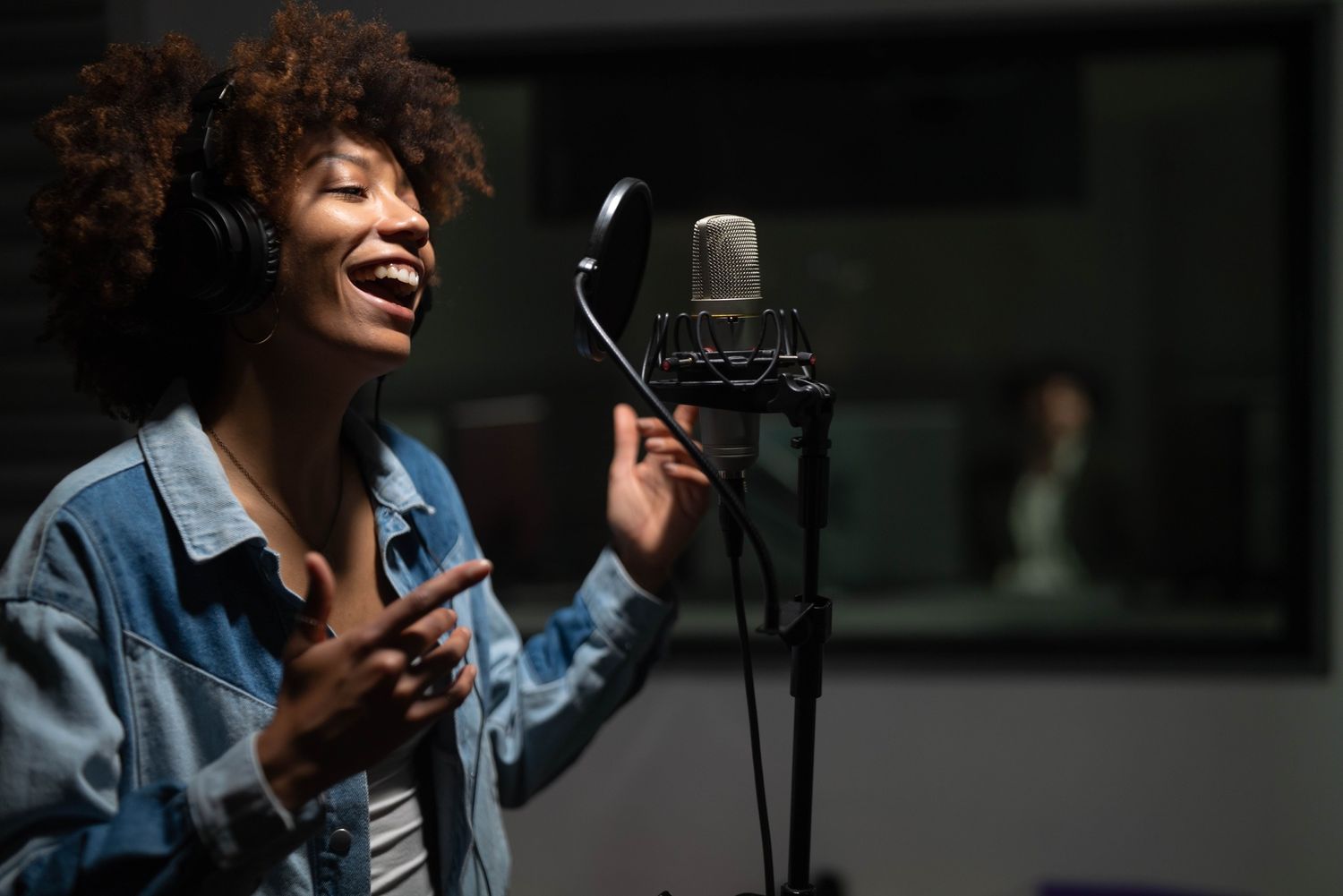Home>Events & Info>Acapella>What Is An Acapella In Music


Acapella
What Is An Acapella In Music
Modified: January 22, 2024
Discover the beauty of acapella music and learn what it truly means to create harmonies and melodies using only the human voice. Explore the versatility and creativity of acapella in this comprehensive guide.
(Many of the links in this article redirect to a specific reviewed product. Your purchase of these products through affiliate links helps to generate commission for AudioLover.com, at no extra cost. Learn more)
Table of Contents
Introduction
Acapella music is a captivating and unique form of musical expression that has gained popularity in recent years. With its roots deeply embedded in the choral tradition, acapella music showcases the power and versatility of the human voice. In this article, we will explore the fascinating world of acapella, delving into its definition, historical background, main characteristics, popular groups, contemporary usage, and techniques for training.
Unlike traditional music that relies on instruments to create melodies and harmonies, acapella music relies solely on the human voice. Singers use their vocal cords, breath control, and vocal techniques to recreate both the melody and accompanying harmonies. The absence of instruments allows for a more intimate and personal connection to the music, as every sound and emotion is created by the human voice alone.
Acapella has a rich and varied history that stretches back centuries. It finds its origins in religious chants and vocal polyphony of the Renaissance era. Over time, acapella music has evolved and adapted, moving beyond religious settings to encompass various genres including pop, rock, jazz, and hip-hop.
One of the defining characteristics of acapella music is the intricate vocal harmonies. Singers blend their voices seamlessly, creating a rich tapestry of sound that is both captivating and soul-stirring. The absence of instruments places a greater emphasis on the precision and control of each vocal part, as singers must work together to achieve perfect synchronization.
In recent years, acapella groups have gained significant recognition and popularity. From Pentatonix, the Grammy-winning ensemble that revolutionized acapella with their contemporary arrangements, to homegrown groups like Street Corner Symphony and Home Free, there is a growing appreciation for this art form. These groups often perform covers of popular songs, but acapella music also boasts a significant original repertoire.
Contemporary music has embraced acapella in various ways, with artists incorporating acapella sections into their songs or remixing acapella tracks to create entirely new compositions. The creative possibilities are limitless, allowing artists to experiment with vocal textures and harmonies in unique and innovative ways.
While acapella may seem effortless, achieving seamless harmonies and precise vocal control requires training and technique. Singers must fine-tune their ears, develop perfect pitch, and master vocal techniques such as breath control, vowel shaping, and dynamic adjustments.
Throughout this article, we will explore the world of acapella music in depth, highlighting its incredible versatility, emotional impact, and the skilled musicians who bring this extraordinary genre to life.
Definition of Acapella in Music
Acapella music, also known as vocal music or a cappella, is a unique style of musical performance where singers use only their voices to create melodies, harmonies, and rhythms without the accompaniment of any instruments. The term “acapella” is derived from the Italian phrase “a cappella,” which translates to “in the manner of the chapel” or “in the style of the church.”
In its purest form, acapella music is performed without any instrumental backing, relying solely on the human voice to produce all elements of the musical composition. However, some acapella performances may include percussive sounds created through vocal techniques such as beatboxing or hand-clapping.
Acapella music is characterized by the intricate blending of voices to create harmonies. Singers work together to produce a choir-like effect by harmonizing individual vocal parts, which typically include the melody, harmony, bass, and vocal percussion. The absence of instruments places a greater emphasis on the precision, control, and coordination of the singers.
Traditionally, acapella music originated in religious settings, where choirs would perform vocal chants and hymns. However, the genre has evolved over time and expanded to encompass various musical styles, including pop, jazz, soul, R&B, rock, and hip-hop.
The versatility of acapella music allows for creative interpretations of both popular songs and original compositions. Acapella groups often arrange well-known songs, adapting them to suit the unique capabilities of vocal performance. This can involve reimagining instrumental elements with vocal techniques or adding intricate harmonies to enhance the overall sound.
It is important to note that acapella is distinct from vocal groups or choirs that may use instrumental accompaniment or backing tracks. Acapella performances focus exclusively on the pure vocal expression and the interactions between singers.
Modern advancements in technology have also influenced the evolution of acapella music. With the aid of recording software and sound editing techniques, singers can layer and manipulate their voices to create complex arrangements. These arrangements can mimic the sounds of different instruments, resulting in a more dynamic and expansive acapella sound.
Overall, acapella music is a testament to the power and versatility of the human voice. It showcases the immense talent and creativity of vocalists who use their voices to create complex melodies, harmonies, and rhythms, transporting listeners into a world where instruments are unnecessary.
Historical Background
The roots of acapella music can be traced back to ancient times, where vocal music played a significant role in various cultures and rituals. Vocal singing was used in religious ceremonies, storytelling, and communal celebrations, forming a vital part of human expression. However, it was during the Renaissance era that acapella music as we know it today began to take shape.
In the 14th and 15th centuries, choral music became an integral part of the Catholic Church. The polyphonic style of composition, which involved multiple voices singing independent lines, took hold. This allowed for the intricate blending of voices to create harmonies, setting the foundation for acapella music.
During the Renaissance period, composers such as Giovanni Pierluigi da Palestrina and Josquin des Prez rose to prominence. They composed stunning acapella choral pieces, many of which were performed in churches and cathedrals. The complexity and beauty of these compositions showcased the full potential of acapella music, with each vocal line harmonizing and intertwining to create breathtaking musical works.
In the following centuries, acapella music continued to evolve and adapt to different musical styles and cultural influences. The invention of the printing press in the 15th century allowed for the widespread distribution of sheet music, making choral works more accessible to a wider audience.
By the 19th and 20th centuries, choral societies and vocal ensembles became increasingly popular. These groups performed acapella arrangements of folk songs, classical compositions, and traditional hymns. African American spirituals and gospel music also played a significant role in the development of acapella music, showcasing the power of vocal expression in religious and cultural contexts.
In the 20th century, acapella music expanded beyond the religious and classical genres. Barbershop quartets gained popularity, with their close harmonies and intricate vocal arrangements. This traditional form of acapella became a hallmark of American music, often performed in social gatherings and barbershop competitions.
With the rise of modern recording technology in the mid-20th century, acapella music experienced a resurgence in popular culture. Doo-wop groups, such as The Drifters and The Platters, incorporated acapella harmonies into their songs, creating a unique and soulful sound.
Today, acapella music is not limited to any specific genre or culture. It has become a global phenomenon, with acapella groups and vocal ensembles spanning various styles, including contemporary pop, rock, jazz, and even electronic dance music. The rich historical background of acapella music continues to influence and inspire modern-day artists, ensuring that this art form remains vibrant and evolving.
Characteristics of Acapella Music
Acapella music is characterized by several distinctive features that set it apart from other forms of musical expression. From the intricate vocal harmonies to the absence of instrumental accompaniment, these characteristics contribute to the unique and captivating nature of acapella music.
1. Vocal Harmonies: One of the defining traits of acapella music is the intricate blending of voices to create harmonies. Singers work together to produce a choir-like effect, with each vocal part harmonizing with the others. From the melody to the accompanying harmonies and bass lines, every voice has a vital role in creating a rich tapestry of sound.
2. Versatility of Voices: Acapella music showcases the diverse range and versatility of the human voice. Singers use various vocal techniques to emulate different instruments, mimicking the sounds of guitars, drums, horns, and more. This versatility allows acapella groups to create complex and dynamic arrangements, giving the illusion of a full instrumental ensemble.
3. Precision and Control: With no instrumental accompaniment, acapella singers must rely on their vocal skills to maintain precision and control. Each voice must be in tune and perfectly synchronized with the others. This requires precise pitching, harmonizing, and breath control, ensuring that the vocals blend seamlessly to create a cohesive and balanced sound.
4. Emphasis on Lyrics and Vocal Expression: In acapella music, the focus is often on the lyrics and the raw emotional expression conveyed through the vocals. Without the distraction of instrumentation, the lyrics become more prominent, allowing listeners to fully immerse themselves in the meaning and message of the song. Singers can also use their voices to convey a wide range of emotions and nuances, adding depth and emotional impact to the performance.
5. Minimalistic Aesthetic: Acapella music embraces a minimalistic aesthetic, with the absence of instruments allowing the pure, unadulterated voices to take center stage. This simplicity highlights the inherent beauty and power of the human voice, showcasing the remarkable capabilities of vocalists and their ability to evoke deep emotional responses without the need for elaboration.
6. Collaborative Effort: Acapella music is a highly collaborative art form. Singers must work closely together, listening and responding to one another, to achieve a harmonious and cohesive performance. Each voice contributes to the overall sound, creating a sense of unity and teamwork that is essential for a successful acapella performance.
7. Creativity and Innovation: Acapella music allows for endless creativity and innovation. Artists can take existing songs and reimagine them with unique vocal arrangements and interpretations. They can experiment with vocal techniques, create vocal percussion, and explore new ways to manipulate and layer their voices. This freedom to push boundaries and explore new frontiers is what keeps acapella music fresh and exciting.
These characteristics come together to make acapella music a truly captivating and unique genre. Whether performed by a large choir or a small vocal ensemble, acapella music showcases the incredible power, versatility, and beauty of the human voice.
Popular Acapella Groups
Acapella music has gained significant popularity over the years, thanks to the incredible talent and artistry of numerous acapella groups. These groups have pushed the boundaries of acapella music, creating unique and captivating performances that have captivated audiences worldwide. Here are some of the most popular acapella groups:
1. Pentatonix: Pentatonix is a renowned American acapella group that rose to fame after winning the third season of “The Sing-Off” in 2011. Known for their impeccable harmonies, creative arrangements, and infectious performances, Pentatonix has become one of the most successful acapella groups in history. They have won multiple Grammy Awards and have released numerous chart-topping albums, showcasing their versatility in covering a wide range of genres.
2. Home Free: Home Free is an acapella country group that gained popularity after winning the fourth season of “The Sing-Off” in 2013. With their impressive vocal abilities and tight harmonies, Home Free has captivated audiences with their unique blend of country and acapella music. They have released several successful albums and garnered a strong fan base.
3. Straight No Chaser: Straight No Chaser is an American acapella group hailing from Indiana University. They gained global recognition after their rendition of “The 12 Days of Christmas” went viral on YouTube. Since then, they have released numerous albums, performed in sold-out concerts, and collaborated with renowned artists. Their repertoire spans various genres, from pop and rock to R&B and holiday music.
4. Naturally 7: Naturally 7 is a unique acapella group known for their mastery of “vocal play,” where they use their voices to mimic different instruments and produce intricate harmonies. Their performances have captivated audiences worldwide, and their collaborations with renowned musicians, such as Michael Bublé, have gained them recognition and critical acclaim.
5. The Swingle Singers: The Swingle Singers, formed in the 1960s, pioneered the modern acapella sound. Known for their innovative vocal arrangements and stunning jazz interpretations, their performances have left a lasting impact on the acapella community. The group has won multiple Grammy Awards and continues to inspire and influence acapella artists today.
6. Vocal Rush: Vocal Rush is a high school acapella group that gained national recognition after competing on the reality TV show “The Sing-Off.” Their youthful energy, powerful vocals, and dynamic performances have earned them numerous accolades and a strong following. Vocal Rush continues to inspire young acapella enthusiasts around the world.
7. Rockapella: Rockapella is a renowned American acapella group that has been captivating audiences since the early 1990s. Known for their unique blend of pop, rock, and soulful harmonies, Rockapella has released several successful albums and has performed in countless shows around the globe. Their iconic theme song for the TV show “Where in the World is Carmen Sandiego?” remains a fan favorite.
These are just a few examples of the many exceptional acapella groups that have made a significant impact on the music industry. Each group brings its own unique style, creativity, and vocal prowess, showcasing the immense talent and artistry within the acapella community.
Contemporary Use of Acapella in Music
Acapella music has found a diverse range of applications in contemporary music, showcasing its adaptability and enduring appeal. Artists and producers have embraced acapella as a powerful tool for creating unique and captivating musical experiences. Here are some ways in which acapella is used in today’s music:
1. Acapella Sections in Songs: Many contemporary songs feature acapella sections where the vocals take center stage without any instrumental accompaniment. These sections provide moments of intimacy and raw emotional expression, allowing the listener to connect more deeply with the lyrics and the performers’ voices. Acapella sections can have a powerful impact and serve as a powerful contrast to the rest of the song.
2. Acapella Remixes and Mashups: Acapella tracks are often used by DJs and producers to create remixes and mashups. By isolating the vocal tracks from popular songs, these artists can recontextualize and combine them with different instrumental elements, creating entirely new compositions. Acapella remixes are a creative way to breathe new life into well-known songs and offer listeners a fresh perspective on familiar melodies and lyrics.
3. Vocal Layering and Vocal Percussion: With advancements in recording technology, artists can layer multiple vocal tracks to create rich and intricate acapella arrangements. Vocal layering allows for the creation of lush harmonies and vocal textures that would be challenging to achieve in real-time performances. Additionally, vocal percussion techniques, such as beatboxing and mouth drumming, are often incorporated into acapella tracks to add rhythmic elements and enhance the overall sound.
4. Acapella Covers and Arrangements: Acapella groups and individual artists are known for their innovative covers of popular songs, reimagining them with unique vocal arrangements. By stripping away the instrumental elements, these artists can put a fresh spin on familiar tunes, allowing the focus to be on the vocals and harmonies. Acapella covers and arrangements can breathe new life into songs, revealing their underlying beauty and showcasing the creativity of the performers.
5. Acapella Virtual Choirs: The rise of online platforms and social media has made it possible for acapella enthusiasts from around the world to come together and form virtual choirs. These virtual choirs collaborate remotely, recording their individual vocal parts and combining them to create harmonious acapella performances. These virtual collaborations allow individuals to connect and make music together regardless of geographical boundaries, fostering a sense of community and creativity.
6. Acapella in Advertising and Film: Acapella music is often used in advertising campaigns and films to create a distinct and memorable auditory experience. The absence of instrumentation can draw attention to the emotions conveyed through the vocals and align them with the message or storyline of the commercial or movie. Acapella music adds a unique texture and authenticity to these visual mediums, leaving a lasting impression on the audience.
The contemporary use of acapella in music demonstrates its versatility and enduring appeal. Whether it is through acapella sections, remixes, covers, or virtual collaborations, acapella continues to captivate audiences with its raw and emotive vocal performances, showcasing the incredible power and beauty of the human voice.
Acapella Techniques and Training
Acapella music requires vocalists to develop specific techniques and undergo training to master the art of performing without instrumental accompaniment. From honing pitch accuracy to perfecting vocal control, acapella singers employ various techniques to deliver captivating and harmonious performances. Here are some key acapella techniques and training methods:
1. Pitch Accuracy and Intonation: Acapella singers must have excellent pitch accuracy, as their voices are responsible for creating both melody and harmony. Training the ear to recognize and match pitches is crucial. Singers practice scales, intervals, and melodic patterns to develop a strong sense of intonation, ensuring that their voices blend seamlessly with others in the ensemble.
2. Vocal Control and Technique: Acapella singers focus on refining vocal control to produce a clean and precise sound. Techniques such as diaphragmatic breathing, vocal warm-ups, and exercises for breath support help singers maintain proper breath control and sustain notes over long phrases. Techniques for vocal placement, vowel shaping, and articulation are also honed to create a unified vocal blend.
3. Harmonizing and Blending: Achieving seamless harmonies and blending is vital in acapella music. Singers practice harmonic exercises where they train their voices to listen and adjust to other voices in the ensemble. This includes understanding chord structures, interval relationships, and the balancing of vocal dynamics to create a unified and balanced sound.
4. Vocal Percussion and Beatboxing: Adding percussive and rhythmic elements through vocal techniques is a popular aspect of acapella music. Singers learn beatboxing techniques to create drum sounds, snare hits, and other percussive elements with their voices. This requires precise control of mouth and throat muscles to produce accurate and distinctive sounds that simulate drum beats and other percussive instruments.
5. Vocal Effects and Textures: Acapella singers often explore vocal effects and textures to enrich their performances. This can include vocal layering, where singers record multiple vocal tracks and combine them to create complex harmonies and textures. Experimentation with vocal timbre, dynamics, and resonance also allows singers to add depth and dimension to their performances.
6. Ensemble Dynamics and Listening: Acapella singing emphasizes the importance of ensemble dynamics and listening skills. Singers must be able to listen carefully to other voices in the group to maintain tight vocal synchronization and balance. They develop an understanding of how their voice contributes to the overall sound and adapt their individual timbre and volume to create a cohesive ensemble blend.
7. Performance Presence and Expression: Acapella singers learn to become engaging performers by cultivating stage presence and expressive delivery. They study conveying emotion through their voices and body language, enhancing the impact of the music. Adding gestures, facial expressions, and storytelling elements can elevate the overall performance and captivate audiences.
Training in acapella techniques can be pursued through vocal coaching, choir participation, acapella workshops, and dedicated practice. Many schools and music organizations offer specialized acapella programs that provide comprehensive training in vocal technique, musicianship, and ensemble performance.
Mastering acapella techniques requires time, dedication, and a genuine love for vocal music. Through training and continuous practice, singers can unlock the full potential of their voices and create exceptional acapella performances that inspire and delight audiences.
Conclusion
Acapella music is a captivating and distinctive art form that showcases the power and versatility of the human voice. Defined by intricate vocal harmonies, the absence of instrumental accompaniment, and a rich historical tradition, acapella music has captured the hearts and ears of listeners across the globe.
From its origins in religious chants and polyphonic compositions of the Renaissance era, acapella music has evolved to encompass a vast range of genres and styles. Contemporary acapella groups have reimagined popular songs, explored vocal percussion techniques, and pushed the boundaries of what is possible with the voice alone.
Acapella music thrives on collaboration, with singers working closely together to create harmonies that blend seamlessly. The precision and control required in achieving synchronization and vocal balance make acapella a true testament to the skill and artistry of the performers.
Popular acapella groups like Pentatonix, Home Free, and Straight No Chaser have brought acapella music into the mainstream, captivating audiences with their breathtaking vocal performances and creative arrangements. These groups have demonstrated the incredible potential of the human voice to mimic instruments, deliver soul-stirring melodies, and evoke powerful emotions.
The contemporary use of acapella in music has expanded its reach even further. Acapella sections in songs, remixes, and mashups, virtual collaborations, and its integration into advertising and film have ensured that acapella remains relevant and constantly evolving.
Acapella singers undergo rigorous training to develop specific techniques, focusing on precision, vocal control, harmonization, and expression. They strive for pitch accuracy, hone their vocal control and technique, explore vocal percussion, and master the art of blending and harmonizing with others.
In conclusion, acapella music offers a unique and mesmerizing auditory experience that celebrates the human voice as the sole instrument. It represents a harmonious collaboration among singers, a profound connection to religious and historical traditions, and a platform for creative expression and innovation. Whether performed in churches, concert halls, or on the internet, acapella music continues to captivate and inspire listeners, highlighting the boundless creativity and beauty of the human voice.











